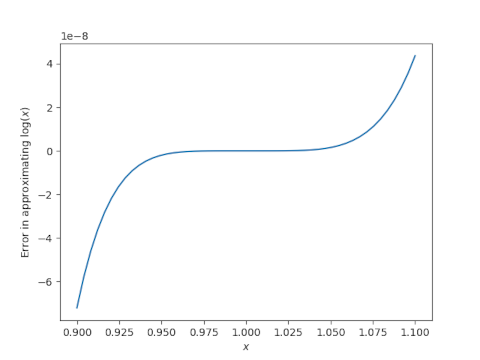The previous post looked at an efficient way to approximate nth roots of fractions near 1 by hand. This post does the same for logarithms.
As before, we assume x = p/q and define
s = p + q
d = p − q
Because we’re interested in values of x near 1, d is small, and small numbers are convenient to work with by hand.
In [1] Kellogg gives the approximation
log x ≈ 3(x² − 1)/((x+ 1)² + 2x) = 6ds/(3s² − d²)
So, for example, suppose we wanted to take the natural log of 7/8. then p = 7, q = 8, s = 15, and d = −1.
log x ≈ (6×15×(−1))/(3×225 − 1) = − 90/674 = − 45/337.
This approximation is good to six decimal places.
Kellogg claims that
This value of E [the natural logarithm], if q [what I’ve called x] be between .9 and 1.1, is true to the seventh decimal.
He then goes on to explain how to create an even more accurate approximation, and how to deal with larger values of x.
Here’s a plot verifying Kellogg’s claim.

Note the that scale of the plot is 10−8. As the flat spot in the middle suggests, you get even more decimal places for x closer to 1.
[1] Ansel N. Kellogg. Empirical formulæ; for Approximate Computation. The American Mathematical Monthly. February 1987, Vol. 4 No. 2, pp. 39–49.

John,
Your citation is slightly off. That paper is not from 1987, it’s from 1897! Here it is: https://www.tandfonline.com/doi/abs/10.1080/00029890.1897.11998939
From the journal: “Their author, the late Ansel N. Kellogg, of Chicago, was for a number of years prominent in newspaper and business circles throughout the country. Though a very busy man, he found time for mathematical meditation, and that he could think efficiently in this domain the paper presented sufficiently.”
I have no idea what relation Ansel N. Kellogg has to the late mathematician Royal B. Kellogg of the University of Maryland.